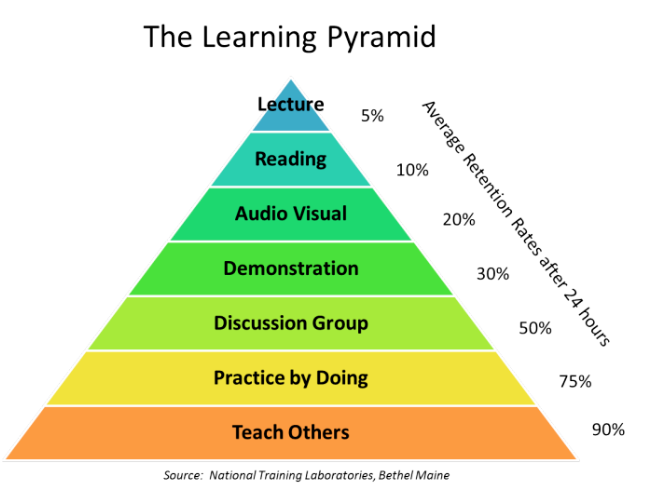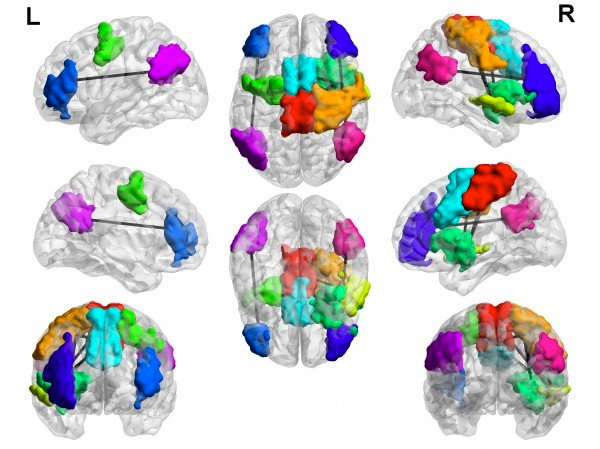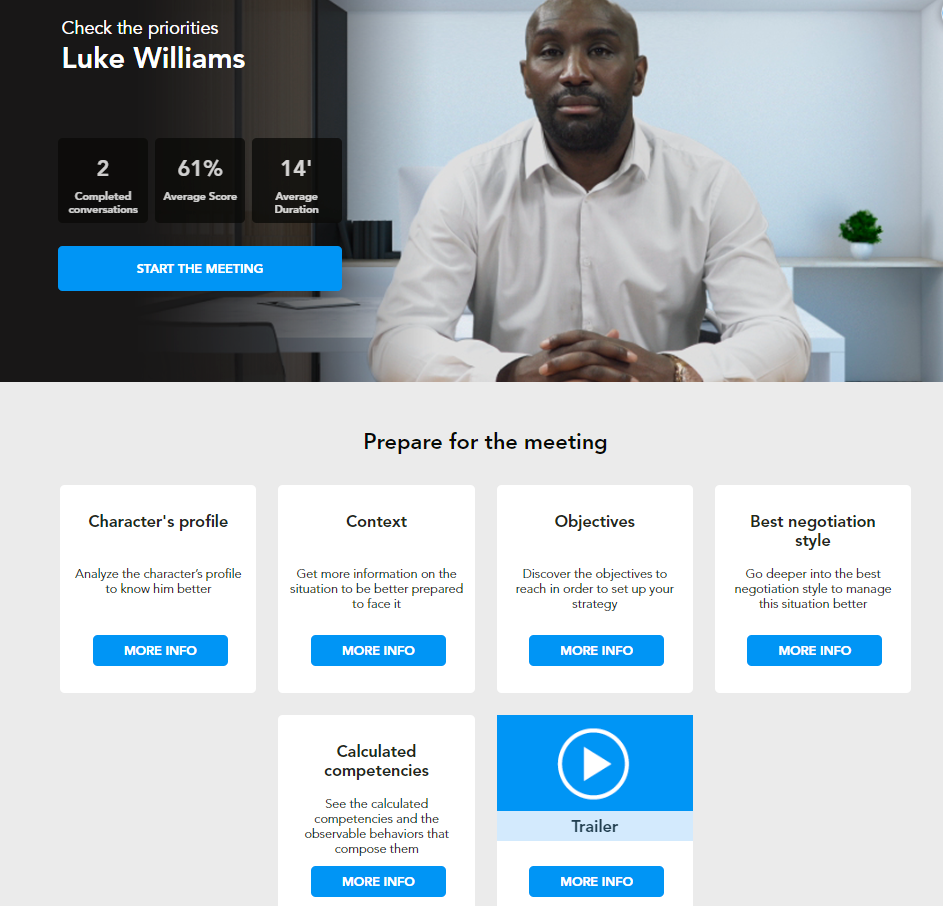
Training adults is always a challenge: adults have enough experience to have already built their own opinions, ideas and habits, which are hard to change.
Besides, they don’t want to waste time, so training has to be quick, efficient and concrete.
That’s why interactive storytelling is a good combo in training: since it reminds them of everyday-life situations, it immediately speaks to them.
Tell me and I forget.
Teach me and I may remember.
Involve me and I learn.
– Benjamin Franklin
Adult learning: a bit of theory
The field of adult learning has been the subject of dozens of studies over the years and different theories have emerged.
According to Malcolm Shepherd Knowles’s Andragogy theory, adults don’t learn like children. And for several reasons:
- Adults need a purpose: kids go to school because they have to, as their parents went before them, and because they are told to. Adults need to know why they have to learn.
It can be a future promotion, acquiring new skills or knowledge, or for a new experience, but regardless of the impetus, adults need to have clear objectives. If they don’t, they will be reluctant to be trained and ultimately learn nothing.
- Adults rely on their experience: adults already have a good deal of experience and background, whether it is social, academic or professional experience, and it must be taken into account in their training.
They already have their own way of thinking and analyzing situations and problems, they have their own ideas and opinions. That’s why training must feed off of all of these elements to bring something fundamentally new.
- Adults don’t like theory: unlike children who learn perfectly well through books and theoretical lessons, adults need task-oriented learning. In other words, they learn best when they “practice”.
Give a problem to an adult and, for him, to solve it and by doing so meeting the challenge is far more effective than any book you can give him.
- Adults like doing things by themselves: whether out of self-pride or search for respect, adults don’t like too much guidance. They tend to prefer autonomous learning and being able to try, even if that means making mistakes and having to start all over again.
By providing the learner an environment where he can try and learn by himself, you will make the training far more effective.
Adults need task-oriented learning. In other words, they learn best when they “practice”.
Storytelling: the answer to adult training
Let’s face it, traditional learning methods are becoming obsolete. It was shown that passive learning like reading, listening and seeing implies that the learner is more prone to forget what he has been taught within 24 hours.
On the other hand, active learning like discussion by storytelling and practice by doing are far more efficient, with a retention rate that can reach 75% after 24 hours.

First of all, what is storytelling? It is a way to carry a message or a lesson through a story, an example of a real situation.
It can be a case study or a role play, for example.
Storytelling helps you share an experience while involving people in a familiar and safe environment.
As it immerses the learners into a concrete, believable and engaging scenario, it helps them gain knowledge through examples and encourages reflection and discussion. It helps the learners think about their past experience.
The information collected is also easier to remember as the learner can identify himself in the situation and reproduce later what he has heard, seen and learned, and by doing so, change his behavior, habits and attitudes.
That’s what makes storytelling one of the most effective methods in adult learning.
Thanks to storytelling, the learner can identify himself in the situation and reproduce later what he has heard, seen and learned and by doing so, change his behavior, habits and attitudes.
SkillGym puts storytelling at the heart of its training method. Our Digital Role Plays are all based on well-defined situations and scenarios that users face in their everyday life: at work, at home, with friends, with colleagues, etc.
These simulations train you to face them the best way possible.
These simulations also include a lot of benefits in training:
- Thanks to the simulations, the user has a purpose and is active in his training. The scenario gives him objectives he has to reach to complete the task assigned. This means that he will remember what he has learned during the simulation better.
- We bring him a tool where he can put into practice what he knows to solve the problem.
- The user finds an engaging conversation where he can feel involved and immersed in something new and familiar at the same time, something that he will be able to reproduce in real life.
And last but not least, we let him do it by himself. He can practice autonomously, when he has time to do so, giving him the opportunity to try as many times as he wants, make mistakes and start again, until he has learned the required skills to reach his goals.
The Deja-vu effect: mirror neurons at work
For SkillGym, the “Deja-vu effect” is THE key benefit of our method and approach.
Read this article (“Self-Awareness: the Single Factor Influencing the Most the Speed of Leadership Development”) for more information on the Deja-vu learning trigger.
Scientific research from Dr. V.S. Ramachandran shows that in our brain, special neurons called mirror neurons automatically apply what the brain sees and does during a simulated scenario.
As mirror neurons are related to imitation behaviors, they are a great tool in training.
Since our brain doesn’t see the difference between reality and a very realistic simulation, training on a simulation activates the mirror neurons, which put into practice in real life what they saw and learned during a simulation.

As people constantly train and practice, their mirror neurons make them unconsciously change and improve their habits without them even noticing it.
That’s why SkillGym encourages a scheduled and regular training regimen: repeating the best skills and behaviors over and over again in the simulations helps the user assimilate them easier and faster and then replicate them in real life.
Storytelling is not only about stories
Story is important, that’s true, but not the only piece. The characters you meet in the scenarios and the way you interact with them is crucial.
Your way of leading the conversation will help you reach your goal…or not.
Because you don’t talk to, support or manage introverted people the same as you do exuberant ones. The way you look at the situation will also depend on your skills to define the type of person you have in front of you.
In SkillGym, we give the characters of our simulations a full biography: age, job, family. We also define their explicit and implicit needs, their problems and their personality.
That means that we also take into account their behavior, their way of thinking and communicating with others and their reactions to stressful situations.
Our objective is to create characters that are totally defined in any aspect, just like real human beings.
This is where we reach authenticity: by providing an immersive experience where every single detail, each nuance of a SkillGym Digital Role Play character resembles real life. In fact, each character can even be described according to the several psychometric models that have been developed by prominent researchers, such as Marston’s DISC®, the Wholebrain® or the MBDI® models.
That’s what makes our Digital Role Plays realistic and instructive for the learner (more on our psychometric approach to character development in this article “Building Authentic Characters for Effective Digital Role Plays”).
Because you don’t talk to, support or manage introverted people the same as you do exuberant ones, the way you look at the situation will also depend on your skills to define the type of person you have in front of you.

Our main goal, as we said, is to involve the user in the story. That’s why we decided to make him a real interested party in the scenario.
In order to do that, we jumped from static storytelling, where the user is only a spectator to the story, to interactive storytelling, where the user fully participates and interacts with the character.
By doing so, the user creates changes and influences the actual course of the story. The possibilities are countless, that’s why our stories are not predefined, and each of the user’s decisions has consequences.
A quick look at a SkillGym Digital Role Play
During the simulation, the learner will interact with a real character, not a puppet or an avatar. The character is embodied by a real actor, with a real body language, personality, way of talking…
You can find more information about the building of a Digital Role Play in this article (“Digital Role Plays, the Best Way to Develop Conversational Leadership”).
The objective is to have the most realistic simulation possible, so that the mirror neurons can come into action and help the learner improve his behavior and skills unconsciously and effectively.
Besides, having a real person in front of you will make the situation more familiar and you will bond to the character and interact more easily with him/her.
Your approach will have visible consequences on the scenario and on the character’s mood, which you can identify thanks to his/her body language.
A SkillGym simulation lasts between 10 to 20 minutes, from the preparation of the meeting to the debriefing and results. Why?
- Because we consider that people are busy and have little time to train,
- Because a short, but repeated effort brings about better results than a single long one,
- Because long simulations can annoy users and cause them to lose focus,
- Because we want to focus on what’s essential and not include details that have very little training interest.
The story we are telling is defined according to several criteria: the type of conversation based on the skills the user needs to train on and the type of problems/situations that the user has to face.
It can be, for example, supporting a teammate who was discriminated against at work, giving a feedback to a collaborator with a low performance, solving a conflict between two people, delegating a task to someone, etc.
Their common trait? They are situations that the user may encounter in his day-to day life.
After the simulation, the user will receive feedback from the character. He or she will give his subjective opinion to a relative or a colleague about the conversation you’ve just had.
This unique asset will raise the learner’s awareness on his behaviors, skills and approach in the conversation. It will help him understand the consequences of what he does and make him reflect on what he could change in his approach to improve his performance.

Characters talking about the conversation you’ve just had with them
It’s always easy to say “I’ll change” just after a conversation, it’s not that easy to really do it in the long term.
That’s why the user will also have what we call a “cold feedback”: you will see the result of your conversation on the character a few days/weeks later.
With cold feedback, the user can really see if his approach and behavior during the conversation concretely changed the character’s approach and if he really reached the objectives or not.

2 weeks after the conversation, you see what the character is doing
Conclusion
Adult learning is evolving, and storytelling appears as the best option to make people change their habits. It’s realistic, engaging, and it involves learners trying and doing things by themselves.
Thanks to Digital Role Plays and scheduled training, SkillGym helps users improve their skills, behaviors and performance effortlessly, providing them a safe environment to complete conversations with authentic characters, who have their own personality and needs, and giving them the opportunity to make mistakes and try as many times as they want with no consequences on others.
Did you find this article interesting? Then, to know more about this subject, don’t hesitate to read our article (“8 Ways your skills will improve by practicing on Digital Role Plays”).
You want to go into the learning theories more in depth, then Learning Theories supporting SkillGym methodology was written for you.
If you are interested in our work and approach, book a 1-hour discovery call here.

